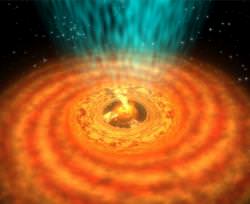After surveying more than 200 stars in various stages of formation, ESA’s XMM-Newton X-Ray Observatory has revealed a dramatically different picture than what astronomers were predicting. Specifically, the observatory helped show how streams of matter fall down onto the stars’ magnetic atmosphere, cooling the atmosphere, and absorbing X-rays.
XMM-Newton targeted new star formation in the Taurus Molecular Cloud; a vast star formation region located only 400 light-years from Earth. Many of these stars are still accumulating new material through a process called accretion. As new matter strikes the star, it heats up, blasting out ultraviolet radiation.
Astronomers expected that the infalling material would heat the stellar envelop so much that it should produce an excess of X-rays as well. But that wasn’t happening. Instead, it appears that the streams of material are so dense, they actually cool the outer atmosphere, and absorb most of the X-rays being emitted.
There should also be large quantities of dust falling into the star that should obscure it from our view, but the stars are seen burning brightly. It must be that the star’s radiation is actually vapourizing the dust before it can reach the star, giving us a clear view.
Original Source: ESA News Release

